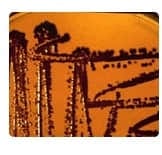Exam Details
Exam Code
:ASCP-MLTExam Name
:MEDICAL LABORATORY TECHNICIAN - MLT(ASCP)Certification
:ASCP CertificationsVendor
:ASCPTotal Questions
:572 Q&AsLast Updated
:Apr 15, 2025
ASCP ASCP Certifications ASCP-MLT Questions & Answers
-
Question 321:
Atherosclerosis is a hardening of an artery specifically due to the build up of plaque. The risk to patients with significant atherosclerosis is that eventually a narrowing of the artery (stenosis) can cause a reduction in oxygen delivery to tissues and plaque rupture can lead to an acute coronary event.
Atherosclerosis is a hardening of an artery specifically due to which of the following?
A. Build up of plaque
B. Aggregation of platelets
C. Hypercalcemia
-
Question 322:
The colonies seen growing on the bird seed agar appear smooth and have a distinct reddish-brown pigmentation. The active ingredient in bird seed (Guizotia abyssinica) agar is caffeic acid, which is extracted and placed in an agar containing
1% glucose. Of the cryptococci, and other species of yeasts, Cryptococcus neoformans selectively produces the enzyme phenoloxidase, which oxidizes the caffeic acid in the medium to melanin, producing the red-brown pigmentation.
The other yeast species included in this exercise do not possess phenoloxidase activity and therefore remain non-pigmented when grown on bird seed agar.
The colonies shown in this photograph were grown on Guizotia abyssinica (bird seed) agar at 30°C for 72 hours. The most likely identification is:

A. Cryptococcus laurentii
B. Cryptococcus neoformans
C. Candida parapsilosis
D. Saccharomyces cerevisiae
-
Question 323:
Which of the following is a selective media recommended for the isolation of Clostridium difficile?
A. Cefoxitin-cycloserine-fructose agar (CCFA)
B. Buffered-charcoal yeast extract(BCYE) agar
C. Kanamycin Vancomycin laked blood (LKV) agar
D. Thiosulphate citrate bile salts sucrose (TCBS) agar.
-
Question 324:
Charcot-Leyden crystals in stool are thought to be created from damaged eosinophil byproducts. These crystals have a strong association, although they are rare, with parasitic infections or allergic reactions. Charcot-Leyden crystals in stool may be associated with an immune response and are thought to be the breakdown products of:
A. neutrophils
B. eosinophils
C. monocytes
D. lymphocytes
E. basophils
-
Question 325:
The correct set of patient data would be: Hgb A = 60%, Hgb S = 38%, Hgb A2 = 2%, Hgb F = 0%
Patients with sickle cell trait commonly have Hgb A values between 40 and 60%, Hgb S values between 20 and 40% and Hgb A2 values between 2 and 3%.
A known sickle cell trait patient has a hemoglobin electrophoresis test performed. Which of the following hemoglobin percentage sets would most closely match this patient's diagnostic state?
A. Hgb A = 90%, Hgb S = 8%, Hgb A2 = 2%, Hgb F = 0%
B. Hgb A = 60%, Hgb S = 38%, Hgb A2 = 2%, Hgb F = 0%
C. Hgb A = 40%, Hgb S = 58%, Hgb A2 = 2%, Hgb F = 0%
D. Hgb A = 25%, Hgb S = 70%, Hgb A2 = 2%, Hgb F = 3%
-
Question 326:
When an antigen comes in contact with the skin, the antigen is processed by cells in the epidermis and come in contact with T lymphocytes. T lymphocytes recognize the antigen as foreign and circulate through the bloodstream back to the epidermis and produce an inflammatory response to eliminate the antigen, but this immune response can produce a characteristic rash in the skin called contact dermititis.
Contact dermatitis is mediated by:
A. B lymphocytes
B. Macrophages
C. Polymorphonuclear cells
D. T lymphocytes
E. Chemokines
-
Question 327:
Pluripotential stem cells are ultimately capable of differentiating into all types of leukocytes.
Hematology
Pluripotential stem cells are capable of producing which of the following:
A. Only T-lymphocyte and B-lymphocyte subsets
B. Erythropoietin, thrombopoietin and leukopoietin
C. Lymphoid and myeloid stem cells
D. Daughter cells from only a single cell line
-
Question 328:
Primary- Target glands (such as thymus, thyroid, parathyroid, etc.) Secondary- Pituitary gland Tertiary- Hypothalamus Match the type of endocrine dysfunction with the appropriate organ:
1.
Target gland
2.
Pituitary gland
3.
Hypothalamus
A. Secondary
B. Primary
C. Tertiary
-
Question 329:
Yellow/gray or orange stopper tubes contain thrombin. Question options:
A. True
B. False
-
Question 330:
Serum alkaline phosphatase is produced in the bone, intestine, and the placenta- but not in the brain. Serum alkaline phosphatase activity is derived from all of the following organs except:
A. Bone
B. Intestine
C. Placenta
D. Brain
Related Exams:
Tips on How to Prepare for the Exams
Nowadays, the certification exams become more and more important and required by more and more enterprises when applying for a job. But how to prepare for the exam effectively? How to prepare for the exam in a short time with less efforts? How to get a ideal result and how to find the most reliable resources? Here on Vcedump.com, you will find all the answers. Vcedump.com provide not only ASCP exam questions, answers and explanations but also complete assistance on your exam preparation and certification application. If you are confused on your ASCP-MLT exam preparations and ASCP certification application, do not hesitate to visit our Vcedump.com to find your solutions here.